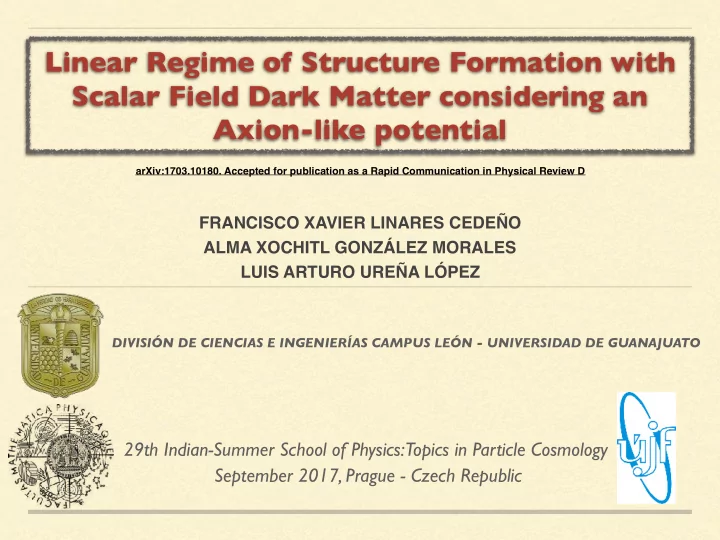

Linear Regime of Structure Formation with Scalar Field Dark Matter considering an Axion-like potential arXiv:1703.10180. Accepted for publication as a Rapid Communication in Physical Review D FRANCISCO XAVIER LINARES CEDEÑO ALMA XOCHITL GONZÁLEZ MORALES LUIS ARTURO UREÑA LÓPEZ DIVISIÓN DE CIENCIAS E INGENIERÍAS CAMPUS LEÓN - UNIVERSIDAD DE GUANAJUAT O 29th Indian-Summer School of Physics: Topics in Particle Cosmology September 2017, Prague - Czech Republic
Several cosmological observations are in agreement with the so called LCDM model!!! Thus, there is about ~25% of matter that we do not “observe”…
MASS POWER SPECTRUM COSMIC MICROWAVE BACKGROUND ANISOTROPIES SDSS collaboration, arXiv:0310723, (2004). Planck collaboration, arXiv:1507.02702, (2016) .
AXION-LIKE PARTICLE (MOTIVATIONS) * Free case * Non-relativitic a.- Scalar Field Dark Matter Simulation b.- N-Body Simulations for CDM Hsi-Yu Schive, Tzihong Chiueh, Tom Broadhurst, arXiv:1406.6586, (2014)
AXION-LIKE PARTICLE (MOTIVATIONS) Strong CP problem in QCD: These particles also emerge in String Theory: R. D. Peccei and Helen R. Quinn, Phys. Rev. D 16 , (1977). P. Svrcek and E. Witten, arXiv:0605.206, (2006).
COSMOLOGICAL EVOLUTION The cosmological equations for a FRW spacetime with null spatial curvature, and matter content consisting in ordinary matter and a scalar field with trigonometric potential are given by: Let us focus on the evolution of the scalar field and its linear perturbation, given respectively by
Klein-Gordon equation (background) Klein-Gordon equation (linear perturbations) L. A. Ureña-López and A. X. González-Morales, arXiv:1511.08195, (2016). F. L , L. A. Ureña-López and A. X. González-Morales, arXiv:1703.10180, (2017).
Klein-Gordon equation (background) Klein-Gordon equation (linear perturbations) L. A. Ureña-López and A. X. González-Morales, arXiv:1511.08195, (2016). Tachyonic Instability F. L , L. A. Ureña-López and A. X. González-Morales, arXiv:1703.10180, (2017).
Klein-Gordon equation (background) Klein-Gordon equation (linear perturbations) Boltzmann Code CLASS (Cosmic Linear Anisotropy Solving System) J. Lesgourgues, arXiv:1104.2932, (2011) L. A. Ureña-López and A. X. González-Morales, arXiv:1511.08195, (2016). Tachyonic Instability F. L , L. A. Ureña-López and A. X. González-Morales, arXiv:1703.10180, (2017).
DARK MATTER DENSITY EVOLUTION F. L , L. A. Ureña-López and A. X. González-Morales, arXiv:1703.10180, (2017).
CMB ANISOTROPIES
MASS POWER SPECTRUM BOSS DR11 Lyman-alpha F. L , L. A. Ureña-López and A. X. González-Morales, arXiv:1703.10180, (2017).
1D-MASS POWER SPECTRUM F. L , L. A. Ureña-López and A. X. González-Morales, arXiv:1703.10180, (2017).
HALO MASS FUNCTION PRELIMINARY RESULT!!! (by Alma González)
CONCLUSIONS & PERSPECTIVES Axion-like particle is a compelling candidate to replace CDM: at large scales it behave just as CDM, and at smaller scales it solve the existing discrepancies between astrophysical observations and simulations based on CDM model. The results were obtained based on: 1) transform the Klein-Gordon equation into a dynamical system, and 2) use an amended version of CLASS code to evolve the linear perturbations. We fully computed the MPS for the axion potential and showed that its features do change significantly in the case when an Axion-like potential is considered, for which linear perturbations in a certain range of wavenumbers suffer a tachyonic instability. This causes the appearance of a bump in the MPS which is close to the cut-off scale, which in turn is also displaced towards smaller scales in comparison to the free case. It will be interesting to know whether future surveys as DESI and LSST, in case a bump and a cut-off in the MPS, or the 1D-MPS are detected, will be able to spot the differences between the free case and the full axion one and in turn put constraints on the decay parameter. Some statistical analysis will be made to constraint the parameters of our model (MCMC, Bayesian Inference).
THANK YOU FOR YOUR ATTENTION QUESTIONS???
Recommend
More recommend